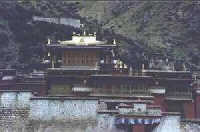|
Curpu Monastery
( 2005-10-27 )
 Built in 1187, the Curpu Monastery is located in Doilungdeqen County, 70 kilometers west from downtownLhasain Southwest China's Tibet Autonomous Region. It is the main monastery of the Black Cap Group of the Gagyu Sect and has been the residence of the Living Buddha Garmabafor several generations. Built in 1187, the Curpu Monastery is located in Doilungdeqen County, 70 kilometers west from downtownLhasain Southwest China's Tibet Autonomous Region. It is the main monastery of the Black Cap Group of the Gagyu Sect and has been the residence of the Living Buddha Garmabafor several generations.
The Garma Gagyu is one of the four major sects of TibetanBuddhism, and the Curpu Monastery is representative of the Gagyu Sect. Built by the first Living Buddha Garmaba, Doisum Qenba, this originally small monastery has evolved into a town of lamas, spread across the mountain slope. The system of succession to grant the Living Buddha began here and has become popular among various sects of Tibetan Buddhism. The 17th Living Buddha Garmaba was enthroned in September 1992.
The Living Buddha Garmaba and Curpu Monastery in which they lived once had great influence on the political and religious situation in Tibet, while at the same time maintaining good relations with the Chinese hinterland.
The 2nd Living Buddha Garmaba, Garmabashi, worked to promote Buddhism in the imperial court ofGenghis Khan. The Mongol Khan Monge granted him a goldsealof authority and a gold-rimmed black hat. From this time onwards, the sect that the Living Buddha Garmaba belongs to has been referred to as the Black Hat Sect.
The 3rd and 4th Living Buddha Garmaba both maintained good relations with the Chinese Imperial Court. The 5th Living Buddha Garmaba, Yinshiba, even visitedNanjing, the capital of theMing Dynasty(1368-1644), where he gave Buddhist sermons.
The Curpu Monastery sits at the foot of the holy Baima Qoinzong Mountain, and there are mediation cells on the peaks flanking the monastery. There are numerous legends related to the mountains, water, and land in the monastery area. The stone tablet, erected in the main hall during the period of the Tubo Kingdom (629-846), is a valuable material for the study on Tubo politics, economy, and culture.
In winter and spring each year, a sorcerer's dance is held at the Curpu Monastery, constituting one of the major religious activities of the monastery and the surrounding area.
|

